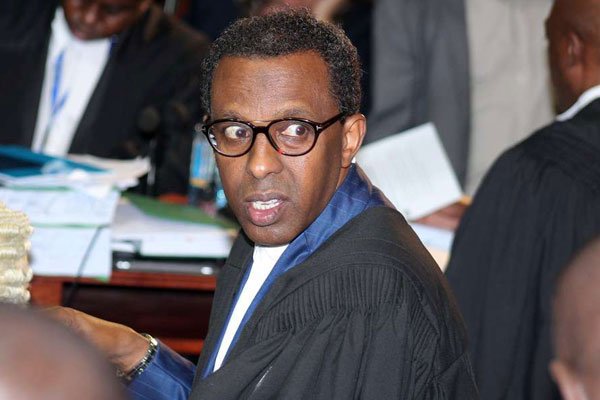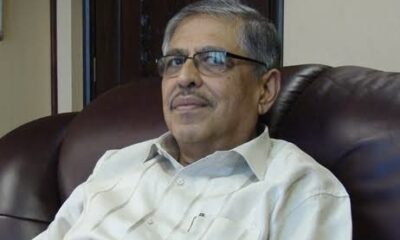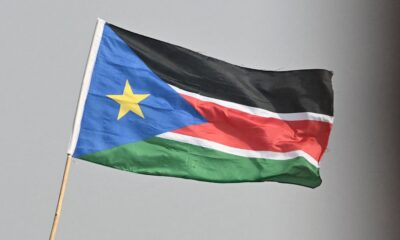News
The Supreme Court And The Arguments, Summary Of The Presidential Petition

Raila Amolo Odinga and Stephen Kalonzo Musyoka told the Supreme Court on Monday the electoral commission did not follow the constitutional provisions regarding elections and said this was grounds for the court to nullify the election of Uhuru Muigai Kenyatta as president.
In response, the Independent Electoral and Boundaries Commission (IEBC) told the Supreme Court that there was no contest of the results declared at the polling station level and therefore the presidential election held on the 8th of August reflected the will of the people.
Through their lawyers, Odinga, Musyoka and the IEBC made submissions on Monday, the first day of hearings into a petition Odinga and Musyoka filed at the Supreme Court challenging the election of Kenyatta as president.
James Orengo, the lead lawyer for Odinga and Musyoka, told the Supreme Court that the constitution should guide the court on whether an election was valid or not.
“When it comes to constitutional provisions, if an election is not conducted in accordance with the constitution then Your Lordships need not look at the results in terms of the numbers garnered by the respective candidates,” said Orengo.
“If there is a transgression that amounts to a violation of any section of the law with regards to the election it may not be considered to be a minor transgression,” Orengo said.
Paul Muite, the lead lawyer for the IEBC and IEBC Chairperson, Wafula Chebukati, told the Supreme Court that the election had been conducted according to the provisions of the constitution, electoral law and regulations.
“My submission is this that in a dispute relating to presidential election, the fundamental issue is the will of the Kenyan people, whether they exercised their sovereignty,” Muite said.
“In the matter before Your Lords you have not been told that there was anything wrong at the polling stations. And it is our submission that the sovereign will of the Kenyan people is captured and can be ascertained by looking at Forms 34A,” said Muite, referring to the form in which the election results at a polling station were recorded.
“Looking at the originals of the Forms 34A should disclose how the Kenyan people decided who should be the president of Kenya,” Muite told the court.
Before the hearing began on Monday, the Supreme Court ruled on an application by Odinga and Musyoka to give their coalition, the National Super Alliance (NASA), access to the IEBC servers to verify the results transmitted from the polling station to the national tally centre. Odinga and Musyoka also applied for a court-supervised scrutiny of the Forms 34A, Forms 34B and Form 34C.
Justice Isaac Lenaola read the ruling on behalf of the other Supreme Court judges. Justice Lenaola said the court decided to grant agents of Odinga and Musyoka access to the IEBC servers but with read-only privileges to protect the security of the IEBC system. He said agents of Kenyatta would be granted the same access and the exercise would be supervised by one of the court’s ICT staff and two independent ICT experts appointed by the court. The experts were ordered to produce a report by 5 pm on Tuesday.
The judge said the read-only access included the firewall without disclosing the software version; the operating system without releasing the software version; the password policy and matrix; the system users and types of access. Justice Lenaola said the agents would also be allowed to see the IEBC’s redundancy plan. He said the agents would be allowed to make copies of what they saw if they needed to.
Justice Lenaola said that separately the Supreme Court Registrar would supervise a scrutiny of certified copies of the original Forms 34A, Forms 34B and Form 34C. Form 34B is the record of the results of all polling stations in a constituency. Form 34C is the record of the results of all constituencies. The Registrar was ordered to produce a report on the scrutiny by 5 pm on Tuesday.
During Monday’s hearing, Odinga’s and Musyoka’s legal team spent five hours arguing for the Supreme Court to annul the presidential election held on 8th of August. Orengo spoke about discrepancies NASA claims it identified between the Forms 34A presented to agents of the presidential candidates at the national tally centre and the forms printed in Dubai. Orengo said the forms printed in Dubai and commissioned by the IEBC had a number of security features. He said forms presented to agents at the national tally centre did not have those security features. Some of the security features Orengo talked about were a watermark that is visible under UV (ultraviolet) light.
Otiende Amollo, another lawyer for the NASA leaders, said they had identified, “32 fundamental breaches and irregularities which in our submission would invalidate this election.”
He spoke about the discrepancies the coalition identified between the results in Forms 34A presented at the polling stations and those Forms 34A uploaded to the public portal the IEBC had. Amollo compared a number of those forms to show that in the Forms 34A uploaded to IEBC’s public portal, the votes for Odinga were reduced and those for Kenyatta increased when compared with the copies of the same Forms 34A that party agents got at the polling station.
Amollo said that on the public portal the margin between the votes for Kenyatta and those for Odinga remained consistent throughout the days before the IEBC chair declared a result. He said a statistician, Dr Edgar Otumbo, commissioned by NASA said the margin between the votes for Kenyatta and Odinga was consistently 11 percentage points.
He said Otumbo observed the results streaming in from the public portal from 7:53 pm on 8th August and up to 1:41 pm the following day and the margin remained consistent. Amollo said Otumbo concluded that, “the results were being held and adjusted through what he called an error adjustment formula.”
Amollo said the formula Otumbo gave was (y = 1.2045x + 183546) with y being the votes for Kenyatta and x being the votes for Odinga.
He said that when it comes to the declaration of the presidential election result, the IEBC did not have all the Forms 34A to be able to determine a result. Amollo said that on the 15th of August NASA received a letter from IEBC CEO Ezra Chiloba in which he said he had enclosed copies of 5,015 Forms 34A and the balance shall be made available to them.
“The CEO is saying that four days after declaring the result we shall comply with the law. This is so fundamental that it is no longer an irregularity but an electoral offense,” said Amollo.
He said that by 11th August, when Kenyatta was declared president-elect, the IEBC said they had not received 10,480 Forms 34A.
“That leads to the conclusion and our submission that the final declaration of the results by (IEBC Chairman) Mr. (Wafula) Chebukati was not supported by Forms 34A,” said Amollo.
“Secondly that the results displayed on national TV as received were unverifiable. And lastly that the results as declared therefore was not based on Forms 34A and Forms 34B as required by law,” he continued.
After the NASA legal team spoke on Monday, Elias Mutuma, who represented Ekuru Aukot, a presidential candidate in the 8th August election, made submissions for about 20 minutes. On Sunday, the Supreme Court granted Aukot’s application to be an interested party in the petition.
Mutuma said his client was not challenging the result of the election. He said his client wanted the court to determine whether the Forms 34A and Forms 34B had been tampered with. He said the Chairman of the Thirdway Alliance Party had analysed the forms given at the national tally centre and compared them with the ones uploaded to the public and found discrepancies. He gave the example of Forms 34B for Bahati and Kuresoi constituencies. He said the Forms 34B given to agents at the national tally centre had the names of agents printed on them but they did not have any totals. The forms for the same constituencies uploaded to the public portal had totals and the names of agents were handwritten.
“The only explanation is someone had time to add the totals, meaning there was room to tamper with the system,” Mutuma said.
“In conclusion, we do not expect that an election process will be perfect. However, we must have minimum standards to be imposed upon election managers. And where election managers fall short of below those standards then the courts should hold them accountable,” said Mutuma.
During the hearing on Monday, lawyers for the IEBC and IEBC Chairman Wafula Chebukati made a joint submission in response to the petition even though they have been named separately as respondents in the case. The court allocated them a total of three hours to make their submissions.
Paul Nyamodi, one of the lawyers for the IEBC, spoke at length about what he described as, “the pathway to a result”. He explained to the court the process that presiding officers followed once votes had been counted in their polling stations. He also explained the process the constituency returning officers followed after collating the results of all the polling stations in their particular constituency.
He also spoke at length about the impact of the Court of Appeal decision earlier this year on the finality of election results at the polling station and constituency tally centre.
Nyamodi also addressed the hacking allegations made by Odinga and Musyoka, which he described as eloquent, “but unfortunately not backed by any evidence. We submit it is a bare allegation, a bare allegation not backed by evidence and we submit not proved.”
PLO Lumumba wrapped up the joint IEBC and IEBC Chairperson submission.
He said the petition lacked focus and was an afterthought.
“The petitioners have made many allegations. They have made many things, but they have not proven anything,” said Lumumba.
“This court should be very reluctant to overturn the will of the people unless it can be demonstrated that that will was subverted,” he said.
He described the work of the IEBC as “midwifery.”
“We delivered a baby. You are being asked to strangle the baby. Decline the invitation because the baby is alive and well,” Lumumba said.
“The totality of our submissions is that we have demonstrated through the various affidavits that this petition is destitute of merit. And because it is destitute of merit it should suffer only one fate: dismissal,” Lumumba concluded.
Summary by KPTJ
Kenya Insights allows guest blogging, if you want to be published on Kenya’s most authoritative and accurate blog, have an expose, news TIPS, story angles, human interest stories, drop us an email on [email protected] or via Telegram
-

 Business2 weeks ago
Business2 weeks ago‘They’re Criminals,’ Popular Radio Presenter Rapcha The Sayantist Accuses Electric Bike Firm Spiro of Fraudulent Practices
-

 Business1 week ago
Business1 week agoIt’s a Carbon Trading Firm: What Kenyans Need to Know About Spiro’s Business Model Amid Damning Allegations of Predatory Lending
-

 Business1 week ago
Business1 week agoManager Flees Safaricom-Linked Sacco As Fears Of Investors Losing Savings Becomes Imminent
-

 News1 week ago
News1 week agoWoman Accused in High Defamation Blames AI As Case Exposes How Mombasa Billionaire Mohamed Jaffer Allegedly Sponsored Smear Campaign Linking Joho’s Family To Drug Trafficking
-

 Investigations2 weeks ago
Investigations2 weeks agoDisgraced Kuscco Boss Arnold Munene Moves To Gag Media After Expose Linking Him To Alleged Sh1.7 Billion Fraud
-

 Africa2 weeks ago
Africa2 weeks agoDisgraced Oil Trader Idris Taha Sneaks Into Juba as Empire Crumbles
-

 Investigations2 weeks ago
Investigations2 weeks agoFraud: How Sh235 Million Donor Cash For Nyamira Residents Was Embezzled Through Equity Bank Under Governor Nyaribo’s Watch
-

 Investigations1 week ago
Investigations1 week agoIntelligence Report Links Budding Politician James Mabele Magio To International Scammers Ring
